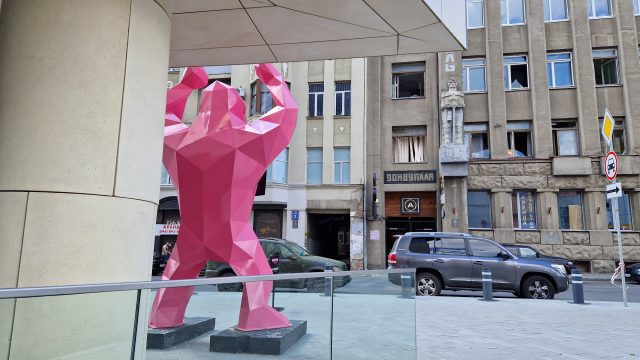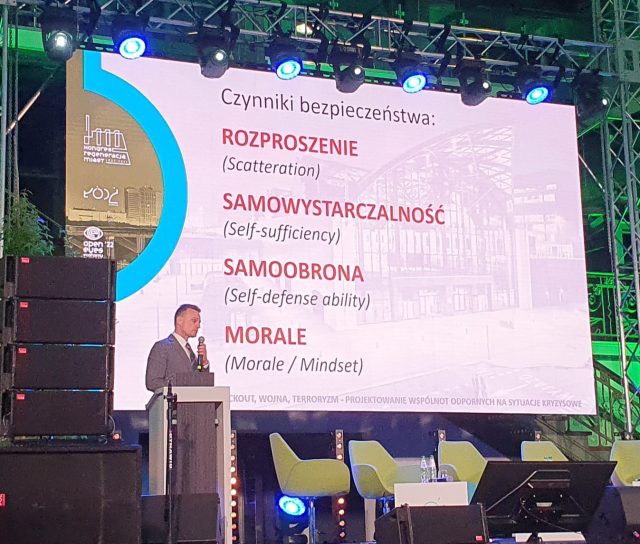Security culture. Explaining the term. And what is urban security culture.
Let’s try to figure it out.
Security is the the most important of human needs. This attracts the attention of the various disciplines representatives and specialists of various fields of activity. Even a cursory review of the definitions of security would lead to long discussions about its essence.
Is security a feeling or a state?
A psychologist, focusing on the fact that this is an existential need, will insist on the first. And, for example, an energy engineer will insist on the second.
Both are right and both will not give a comprehensive answer. Because it is a puzzle consisting of many components.
An attempt to combine them, although very simplified, can lead to the following formula: security is a feeling (of predictability, controllability of personal or group existence) based on a certain state (security, stability or fortitude).

But there is always a “but”… The state of security will not arise by itself, it must be constructed. So it is about activity based on awareness of threats and related challenges. And it has to be carried out despite the idea fixed in the collective consciousness that “security is the absence of dangers.” So, the general formula “awareness-activity-state-feeling” can outline the components of our puzzle in a certain way.
And again “but”. This formula is an abstraction, it acquires specific features only in the context of specific threats. This is how they appeared: road safety, food safety, environmental safety, information, energy or criminal security… You can go on. They are based on a chain – from the awareness of threats to the algorithms of reactions to them. This approach is expedient because people who have worked with it have faced difficult, sometimes tragic consequences of either the total absence of this chain or the weakness of one of its links. [Ukrainian bezpeka stands for both security and safety; urban security is the closest equivalent to cover security and safety within the context – translator’s note]
What is the urban security culture?
Over time, this led to the emergence of such a category as security culture [1]. Among the many definitions of culture, we should turn to this one. This is the quality of society or its individual groups. And it is reflected in the norms and values that regulate the relations of people with the environment of which they are a part and the relations of people among themselves. And, thus, characterize the peculiarities of their consciousness and behavior, that is, the way of being.
Culture, which is based on the value and quality of human life, is determined by the ability to perceive and assess threats, to act individually or collectively in the face of challenges. Specialists working on this use different terms: protection, preservation, safety, security. The choice depends on the proposed responses to threats and the corresponding action algorithms.
We can assume that the reason for such terminological and therefore effective diversity is the dynamics of modern life, which produces threats much faster than we have time to comprehend them, react to them accordingly and change the way of being.
The city is a vivid example of this dynamic and the extremely complex phenomenon. Particular attention to it is not accidental, because urbanization itself provokes threats and challenges that require serious attention. They are included in various safe city models. Mostly, these models were created within the concept proposed in 1956 at the Harvard Graduate School of Design (HGSD). Their classic tasks are to ensure the personal safety and health of citizens. Energy, climatic, economic, social or ecological threats become the basis for work on the desired states of cities.
The city is a system
The models are also based on the assumption that the city is a system that must develop and change. And, at the same time, it is paradoxical and inconsistent inside. After all, its different elements develop at different rates. Thus, over time, the idea of a balanced urban system began to dominate.
But the security of cities consists of many factors, including not so obvious ones. A specific exception was the design of cities that felt the influence of obvious threats – seismic (USA and Japan), demographic (Singapore), terrorist or military (Israel, where the modern concept of city design involves the creation of “citadels” – places whose task is to preserve people’s lives under time of attacks).
And here it should be mentioned that the concept of urban design came to life after the Second World War, when moods and expectations were aimed at the peaceful development of cities. And that is why we consider the Israeli experience here as an exception. Even despite the “cold war”, the desire for a sense of comfort as an analogue of the state of security began to prevail. Moreover, over the time the perception of infrastructural, environmental, or energy threats began to dominate.
The further, the less military threats were seen as possible. Unfortunately, they do exist. The experience of Ukraine confirmed this in a direct way. The war that Russia is waging is an urban war. Cities are deliberately turning into battlefields. This increases losses, economic, managerial and human. Large and small cities are losing the functions of the centers. And this is not the worst option. Because the new realities testify to urbicide – the destruction of civilian objects, terrorist actions against the civilian population with elements of genocide. Let’s leave it to the international courts…
But this became possible also due to the unpreparedness of Ukrainian cities, in the design and construction of which such developments were not taken into account. Moreover, we are talking about systemic unpreparedness not only for military threats, but also for any crisis phenomena – technogenic, climatic, or resource deficiency.
City security as preparedness for threats.
Perhaps this became a kind of trigger that influenced the understanding of city security by experts as preparedness for threats. This was the subject of a report by Dr. Michal Dominczak from the Technical University of Lodz (Poland) at the II International Congress on Climate Restoration of Cities in early June 2022. The previously planned topic of climate change as a source of threats does not lose its relevance. But, unfortunately, a military component is added.

The report is based on the city’s ability to make immediate changes. And we are talking about such a cultural quality as the proportional readiness of all its subsystems (the economy of the city, ensuring its vital activities, community involvement in city processes), which is a guarantee of balance.
Schematically, this report can be divided into four components:
Self-sufficiency of the city.
Self-sufficiency of the city, which could potentially fall into a state of crisis. The resource of the city, which must be created and secured in advance, consists of simple components: energy; water; food; communications; transport.
Diversification.
Promoting the diversification of energy sources and supplies includes:
- promotion of local/community energy production [2];
- support of permanent small-scale (local) energy production based on renewable sources (through water, biomass sources, etc.);
- use of reserve energy sources, including non-renewable ones, as an emergency resource;
- measures to ensure independent (protected) supply of water and food;
- changes in the definition of biologically active (favorable) territories – assistance to communities in self-sufficient supply and food production;
- the organization of urban farms (urban farms), for example through the creation of specialized green spaces;
- support for the construction of local drinking water wells;
- promoting the storage and effective management of rainwater, especially at the community scale (MPZP provisions).
Citizens’ motivation.
Self-defense and self-organization is based on the concept of “invisible shield”. The speaker labeled it as Citizen Motivation. It is this component of the report that reflects the need to take into account the unfortunately real crisis factor – military threats and includes the following components:
- social (civic) integration;
- civilian counterintelligence (awakening of social consciousness through education; recognition of threats; prevention of hostile influences);
- pro-defense education (sports and military training; improvement of procedures for countering threats; timely access to weapons; development of territorial defense);
- systematic interaction of citizens with territorial defense units and the police.
This particular component is gaining some popularity in Poland today. Dr. Dominchak noted that this may be one of the consequences of what is happening in Ukraine. It seems so. But there is an extremely important and perhaps not yet obvious aspect here. Consideration of threats takes place in the context of organizing community life during a crisis. And this became the basis of the fourth component.
Strengthening of small communities in the city.
Strengthening of identity and connections in small areas – communities (including through the legislative consolidation of councils of residential areas) includes:
- creation in the administrative-spatial structure of a system of micro-district settlements on a scale of two to four thousand people (due to provisions on changes in national legislation);
- support of communities for the purpose of local production of energy, food and water saving;
- integration of areas of activity in crisis conditions through local/public educational initiatives.
Preparing the city for the crisis.
Therefore, self-sufficiency of the city, diversification of energy sources and supplies, motivation of citizens, strengthening of identity and connections in local communities are very specific areas of preparation of the city for any crisis phenomena. And this is not only provoked by a military threat. Because climatic challenges, natural disasters or man-made disasters can also act as an enemy for the community. And the quality of the community, its motivation is one of the conditions for the preservation and further development of the city.
By the condition of these ideas are put into practice, such a formula could outline what will one day be called an urban security culture. And it seems that it should be based not only on protection, preservation, safety or security.
The culture of urban security as a way of being can be based on readiness to an action.
This requires changes. And the main thing is the construction of communities that are motivated to such changes. There is time. But there is not too much time.
Ihor Dubrovskyi
Notes
- The combination of the concepts of “culture” and “safety” was first implemented by the International Atomic Energy Agency in 1986 in the process of analyzing the causes and consequences of the accident at the Chernobyl nuclear power plant. It was recognized that a low level of safety culture was one of its causes. Over time, there was an understanding that the security culture category should be applied not only to the personnel of potentially dangerous facilities, but also to various areas of human activity. And today we can meet such phrases as nuclear security culture, cyber security culture, digital security culture or societal security culture.
- Here it is important to pay attention to the provisions of the MPZP (Miejscowy plan zagospodarowania przestrzennego), or the Local Plan for Spatial Development – regulatory and legal acts that determine the target use of land, the distribution of state-targeted investments and determine the manner and conditions of land development.
We advise you to also read: SAFETY CULTURE AS A SYSTEM OF KNOWLEDGE AND A CONDITION FOR SUSTAINABLE DEVELOPMENT OF SOCIETY



